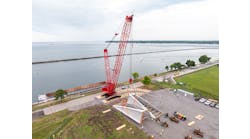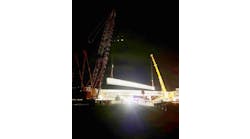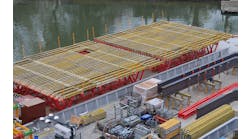By: Lou Dzierzak
Reacting to the sudden failure of the I-35W bridge over the Mississippi River in Minneapolis, Amy Klobuchar, Minnesota’s Democratic senator, said, “Bridges in America just shouldn’t fall down.” Although the statement is hard to disagree with, the Aug. 1 bridge collapse is not the only such tragedy on record.
In 1989, the Loma Prieta earthquake in California brought down a 50-ft section of the San Francisco-Oakland Bay Bridge. Natural disasters can be called “unforeseen acts of nature” but neglected maintenance and faulty design also have played a role. The National Transportation Safety Board ruled that Tennessee’s Department of Transportation failed to identify, evaluate and correct defects that led to the collapse of the U.S. Highway 51 bridge over the Hatchie River in 1989.
In December 2000, two of the three major girders supporting the Hoan Bridge in Milwaukee failed. Months later, investigators questioned the engineering design of the bridge. Intended to bend instead of break, bridge components failed to withstand frigid Midwestern winter temperatures and heavy commercial truck traffic.
In response to the I-35W collapse, Minnesota Gov. Tim Pawlenty ordered his department of transportation to inspect every major bridge in the state. Duane Hill, P.E., assistant district engineer, operations for the Minnesota Department of Transportation (Mn/DOT), said, “If you look back through history, when there has been a bridge collapse, one of the first reactions at a high level of government is to direct their employees to inspect every bridge to restore public confidence.”
Hill, Mn/DOT’s operations manager in the Duluth region, received a temporary assignment to coordinate the statewide bridge inspection effort based on Gov. Pawlenty’s directive. Hill explained the scope of the project. “The first part is completing the bridge inspections. The bridge inspection fieldwork is on track to be finished by Dec. 1, 2007. The second is a stem-to-stern review of the state’s bridge inspection program that is expected to be completed by July 2008. An outside firm will be brought in to do the review.”
Shortly after the stepped-up inspection process started, a bridge over the Red River between Robbin, Minn., and Drayton, N.D., was closed due to a cracked support bracket. Repairs were made and the span opened to traffic four days later. Several other bridges also were closed. According to Hill, the closures were not the result of unexpected findings during inspections but accelerating plans already under development.
Doubled duty
Under normal circumstances, most bridges in Minnesota are on a two-year inspection cycle. Older bridges in poorer condition are inspected annually. Pawlenty’s decree instantly strained Mn/DOT’s resources. Hill said, “With half an inspection season left, we more than doubled our remaining workload for the year. We didn’t have the resources to complete that work.”
Minnesota entered into an emergency contract with PB Americas Inc. to supplement the Mn/DOT inspection staff. Hill described their role as critical.
“PB Americas is focused on inspecting approximately 75 bridges that were classified as ‘fracture critical,’ defined as a bridge with a steel structure without redundancy. For example, a bridge created with steel girders. If one girder collapsed, the bridge would fail. There are six to seven two-person inspection teams working across the state.”
As of Oct. 12, 150 of 231 in-depth fracture critical and special inspections have been completed.
Professional requirements for bridge inspectors are set by national bridge inspection laws and implemented on a state-by-state basis. Hill reported, “To be a lead inspector you have to be either a professional engineer with a background in bridges or have at least five years of experience working on bridge inspections with someone who is a lead inspector.”
Hill described an in-depth two-week bridge inspection course that augmented his professional experience. “The first part covers engineering concepts of all bridges, the different types of materials that are used in bridges and the general defects you see in those materials. The second week goes into the inspection techniques and how you describe what you see.”
Rating systems like the Federal Highway Administration’s (FHWA) 134-page “Recording and Coding Guide for the Structure Inventory and Appraisal of the Nation’s Bridges” document outlines rating language. Hill said, “The rating system looks at the overall condition of the deck, the superstructure and the substructures. Almost every state then goes into very detailed rating of each element of the bridge. For example, if you have a multi-girder bridge, each foot of each girder is rated. So you can have a percentage or number of feet of each girder in different or varying conditions because of different exposures to the elements and the deterioration caused by that.”
Since every state has a slightly different rating system terminology, creating a common language among engineers can be challenging.
“A good part of the [inspection] course is going through the rating process,” explained Hill. “In a classroom setting you look at photographs of bridge components in various stages of deterioration and work independently to determine what the rating should be. At the end, the group discusses how you reached your rating code. Initially everyone sees something different, but by the end of the week the entire group of inspectors gets to the same answer almost every time. That takes the subjectivity out of the rating process when you use and understand the guidelines that have been established.”
FHWA spokesperson Nancy Singer described the inspection process. “Bridge inspection techniques and technologies have evolved over the years. As technology has advanced, so have the tools and methods that have become available to a bridge inspector. Even with more advanced technologies, however, visual inspection remains the primary method to perform bridge inspections along with other more traditional approaches.”
“A key component of a bridge inspection is a visual hands-on,” Hill added. “Most inspectors use a format to record and document the information they see about the bridge. They have a systematic way of looking through the bridge at all the components and identifying defects. As a bridge ages, there are a lot of things you expect to see and then things that are in a worse or more deteriorated condition. The key component is documenting what is there.”
Threats to health
Bridge inspectors have access to specialized methods, tools and techniques to support visual examinations. Singer explained, “Many of the traditional methods are low-tech, but they are proven effective in inspecting bridges and are common practice. These include the techniques of mechanical sounding to identify delaminated concrete and dye-penetrant to identify cracks in steel components. More state-of-the-art methods include radiography, ultrasound and x-ray technologies. These are considered nondestructive-evaluation (NDE) methods because they don’t interfere with the physical properties of the bridge.”
New testing methods being used in aerospace and nuclear industries may have application in future bridge inspection procedures.
“These technologies have the potential to supplement bridge inspection practices, but the challenge is to find a way to make them efficient, effective and practical for field use,” noted Singer.
Often far above a roadbed or major waterway, visually inspecting hard-to-reach bridge components can be tricky. Hill described one solution to the problem. “We have a number of different means to access the bridges. An under-bridge inspection vehicle we use has multiple knuckle booms. With the vehicle on top of the bridge we have a work platform that extends down and underneath the bridge that allows you to move around.”
When inspectors find bridge components in need of attention, traffic, age and weather are the most common contributing factors. Hill said, “The biggest thing that causes fatigue on pavement or bridges is heavy commercial trucks. You start to see more stresses in the structural components due to accumulated fatigue over time.”
Hill stated that age and exposure to the elements has even more impact than truck traffic. He explained, “The combination of age and exposure to the elements is the biggest cause of bridge deterioration. In fact, on most structures across the nation, fatigue doesn’t play a role in deterioration. It’s more weathering and age. A lot of the infrastructure just doesn’t see the heavy commercial traffic and enough load cycles to cause fatigue damage. The biggest factor is weather and age, and if you narrow that down farther, it’s the exposure to moisture.”
As bridge components age, deterioration that is unchecked can expand rapidly. Hill described how the process accelerates. “The cumulative effect of a component that isn’t functioning as it should causes the rapid deterioration. An example is a beam that’s sealed with paint. A paint system will deteriorate at a slow rate initially but eventually it’s going to get to the point where you get moisture and corrosion underneath that will cause the failure of the paint system to occur more rapidly. In addition, the corrosion starts to affect the underlying steel. If you don’t treat that steel soon enough, the corrosion will have a bigger and bigger impact in a short period of time. Once it gets wet, the rust conditions grow rapidly.”
In Minnesota and other Snow Belt states, heavy use of deicing chemicals can take a toll. “In the winter the water carries a lot of salt from deicing chemicals to the substructure and superstructure. That’s another component in deteriorating bridges in Minnesota right now.” Removing ice to prevent accidents on top of the bridge can lead to problems underneath. Hill continued, “One of the measures we use in determining the conditions of a bridge deck is looking at the chloride content that has penetrated into the concrete. A factor we use in making a determination whether we do a new overlay or replace it is how much chloride is in it. Once that salt gets to the rebar it can lead to bigger problems. The ability to perform preventive maintenance is another factor.”
Since the collapse, Mn/DOT has shifted resources from preventive maintenance to reactionary repairs. Hill described the distinction, “Preventive maintenance is ongoing functions like greasing bearings and sealing cracks that are scheduled cyclically. Reactionary work is addressing deteriorated steel that may need extra plating to add strength. Since the first of August we have been making reactionary a higher priority with the funds we have available.”
As the tragic bridge collapse in Minnesota fades in the collective commuter’s memory, bridge inspectors are redoubling their efforts to identify and address conditions that caused the problem in the first place. The political battles over funding road and bridge maintenance have already begun. Hill believes paying attention to ongoing maintenance paid tremendous dividends. “In my experience, when you perform preventive maintenance on bridges that aren’t subject to significant repetitive loadings, you can get really long life out of those bridges,” he said.
About The Author: Dzierzak is a freelance writer based in Richfield, Minn.


